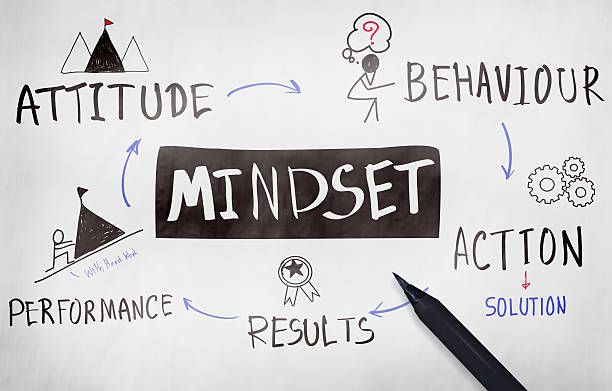10 Growth Mindset Activities for Personal Development

In the relentless pursuit of greatness, there lies a hidden key—a key that unlocks the door to unbounded potential. It's a key that Navy SEALs understand better than most. These elite warriors have mastered the art of exceeding their own limits, not solely through physical strength or tactical prowess, but through a mindset—a growth mindset.
One extraordinary example of this mindset in action is the journey of David Goggins. He wasn't born with innate talent or advantage, but he chose to embrace the principles of a growth mindset. Goggins, once overweight, embarked on a journey that saw him shed over 300 pounds, transform himself into an ultramarathon runner, and achieve feats that seemed impossible. His story is a testament to the power of the human spirit when fueled by a growth mindset.
Goggins' journey serves as a powerful reminder that anyone can rewrite their story by embracing a growth mindset. It's time to embrace challenges, learn from every experience, and become the architect of your own growth—a journey that mirrors the indomitable spirit of both Navy SEALs and the remarkable David Goggins.
What Exactly is a Growth Mindset?
A growth mindset is the belief that abilities and intelligence can be developed through dedication, consistency, and hard work. It's the understanding that challenges and setbacks are opportunities for learning and improvement, rather than indications of failure.
For example, think of Michael Jordan, widely regarded as one of the greatest basketball players of all time. He didn't become a legend overnight; he faced numerous failures and setbacks in his career. However, Jordan's growth mindset propelled him to persevere, continually improve his skills, and ultimately achieve unparalleled success on the basketball court.
Fixed vs Growth Mindset
Fixed Mindset: This mindset sees abilities and intelligence as static traits, something you're born with and can't change much. Individuals with a fixed mindset often avoid challenges, fear failure, and see effort as fruitless because they believe they either "have it" or they don't.
Growth Mindset: In stark contrast, the growth mindset is all about believing in the power of improvement. It sees challenges as opportunities, embraces effort as a path to mastery, and views failures as stepping stones on the journey to success.
#1 Challenge Your Limits
In the realm of personal growth, there's a saying that goes, "Life begins at the end of your comfort zone." This simple yet profound statement encapsulates the essence of our first growth mindset activity—going beyond your limits.
Our comfort zone is like a cozy cocoon where we feel safe, secure, and at ease. It's where we're shielded from discomfort, uncertainty, and risk. But here's the catch: the comfort zone is also where growth stagnates. Inside this bubble of familiarity, we tread the same ground, repeat the same patterns, and rarely reach our true potential.
Why? Because true growth, both personal and professional, happens when we willingly step into the discomfort zone.
Thomas Edison's story teaches us that the path to greatness is often littered with failures and setbacks. Yet, those who embrace a growth mindset never give up. They view challenges as opportunities and persevere, even when the odds seem insurmountable.
To cultivate a growth mindset, we must be willing to explore uncharted territory, take risks, and stretch beyond what we know.
#2 Master Resilience
Surviving life-threatening situations demands a mindset that can bounce back quickly from the unexpected. It's a lesson ingrained in every SEAL's training, and it's a lesson that can profoundly impact our lives as well.
When Navy SEALs prepare for a mission, they are meticulously briefed on the situation they'll face. They receive information on the layout of the target, the number of individuals involved, the weapons they might encounter, and even strategies for navigating the environment covertly.
Yet, here's the reality: almost 100% of the time, things don't go as planned. SEALs might find an unexpected obstacle that challenges their mission's success. However, their response to these unforeseen circumstances is what sets them apart.
Navy SEALs don't waste precious seconds assigning blame, complaining, or retreating when they encounter unexpected challenges. Instead, they follow a simple yet powerful mantra: "Acknowledge; Accept; Adapt; Act."
- Acknowledge: They recognize the obstacle or problem immediately.
- Accept: They calmly accept that the situation has changed.
- Adapt: They adjust their plans and tactics on the fly.
- Act: They keep moving forward toward their objective.
To develop a growth mindset, we need to train ourselves to respond to unexpected challenges with the same grace and determination as a Navy SEAL. We must embrace the notion that setbacks are opportunities for learning and growth, not reasons for giving up.
#3 Break Goals Down Into Smaller Chunks
Elon Musk dreams of colonizing Mars and revolutionizing sustainable transportation, goals that seem light-years away. Yet, Musk's secret lies in his ability to slice these immense objectives into manageable, bite-sized chunks.
Take the example of Tesla's electric vehicles. Musk didn't wake up one day with the ambition to disrupt the automotive industry; he methodically divided his vision into practical steps, called "The Master Plan":
- Create a low-volume car, which would necessarily be expensive
- Use that money to develop a medium-volume car at a lower price
- Use that money to create an affordable, high-volume car
- While doing the above, also provide zero emission electric power generation options
The genius of this approach isn't just in making goals more manageable; it's in keeping the fires of motivation blazing. Each small step forward not only brings you closer to your ultimate objective but also provides a sense of accomplishment that fuels your determination.
Related: This is how Elon Musk uses Timeboxing for maximum productivity
#4 Recite a Mantra
In the pursuit of a growth mindset, one of the most potent yet simple tools at your disposal is the mantra. A mantra is a brief, affirmative phrase or word that you repeat to yourself regularly, acting as a mental anchor that grounds you in the principles of growth, resilience, and determination.
Individuals with a growth mindset understand the profound impact of mantras. These empowering phrases serve as a source of motivation and a shield against negativity. They help you maintain focus, summon courage, and reinforce your mental toughness, especially when faced with challenges.
Crafting your own mantra is a personalized journey that aligns with your growth mindset goals. Your mantra should be concise, meaningful, and inspiring. Here are five examples to get you started:
- "I embrace challenges as opportunities."
- "Every setback is a setup for a comeback."
- "I thrive on continuous learning and improvement."
- "I am resilient and adaptable."
- "My potential is limitless, and I am in control of my growth."
Someone with a growth mindset knows how to motivate themselves with mantras. Once you've chosen or created a mantra that resonates with you, integrate it into your daily life. Recite it silently during moments of doubt, when facing adversity, or when you're pushing the boundaries of your comfort zone.
#5 Transform Your Environment
To truly embrace the principles of growth, consider making deliberate changes to your environment. Here are a few tips:
- Surround yourself with positive people. The people you spend time with have a profound impact on your mindset and well-being. Choose to be around positive people who support your goals and believe in your potential. These are the people who will lift you up, challenge you to grow, and celebrate your successes.
- Create a growth-oriented environment. Your physical space should reflect your aspirations and fuel your motivation. Organize your space and decorate it with symbols of growth and inspiration. For instance, you could hang up a vision board that displays photos of your goals.
- Seek out growth opportunities. Actively look for ways to step outside of your comfort zone and learn new things. This could involve taking on new challenges at work, enrolling in a class, or attending a workshop. When you expose yourself to new experiences, you open yourself up to new possibilities.
Remember, your surroundings are a powerful force that can either empower or hinder your growth. By making deliberate changes to your environment, you can create a space that supports your growth mindset and helps you achieve your goals.
#6 Visualize Your Success
Numerous studies have unveiled a fascinating aspect of our brain's functioning: it cannot distinguish between a real, lived experience and a vividly imagined one. When you close your eyes and visualize a specific goal or outcome, your brain reacts as if you were actually living that experience. This incredible phenomenon has garnered extensive support from research in neuroscience and psychology.
Imagine yourself achieving a challenging goal, like giving a flawless presentation, running a marathon, or acing a job interview. As you vividly picture every detail—the sights, sounds, and emotions—the neural pathways in your brain light up. The regions responsible for motor skills, memory, and emotional response become active, just as they would during a genuine accomplishment.
Find a quiet space, close your eyes, and vividly imagine your goals and aspirations. Feel the emotions associated with your success, immerse yourself in the experience, and let your brain register it as reality.
Here is why Visualization Works
- Mental Rehearsal: Visualization allows you to mentally rehearse the steps needed to reach your goals. Whether it's perfecting a skill, overcoming an obstacle, or achieving a milestone, you're essentially training your brain for success.
- Confidence Boost: Regular visualization can enhance your self-confidence. As your brain repeatedly witnesses your success in your mind's eye, it becomes more convinced of your capabilities. This increased self-belief can be a driving force behind your growth journey.
- Stress Reduction: Visualization can also help manage stress and anxiety. By mentally rehearsing challenging situations and envisioning successful outcomes, you become better equipped to handle real-life stressors with composure and resilience.
- Goal Clarity: Visualization sharpens your focus on your goals. It crystallizes your objectives, making them more tangible and attainable.
You may also like: Daily habits of Highly Successful People
#7 Turn Words Into Action
When you make a promise to yourself, you're essentially setting a goal—an expectation that something will be accomplished. Whether it's a commitment to complete a project, achieve a fitness milestone, or take a step toward your dreams, you're establishing a growth path.
Committing to your promises is not always easy. Life throws curveballs, and obstacles can stand in your way. However, a growth mindset is about embracing challenges and viewing them as opportunities for growth.
How keeping promises can help you develop a growth mindset:
- It teaches you to set goals and create a plan to achieve them. When you make a promise, you're taking the first step towards achieving a goal. You have to think about what you need to do to make the promise a reality, and then create a plan to get there. This process helps you to develop your goal-setting and planning skills.
- It builds your self-discipline and resilience. Keeping promises is not always easy. There will be times when you have to overcome challenges and setbacks. However, when you stick to your promises, you're building your self-discipline and resilience. These are essential skills for anyone who wants to achieve their goals and develop a growth mindset.
- It boosts your confidence and self-belief. When you keep your promises, you're proving to yourself that you're capable of achieving your goals. This boosts your confidence and self-belief, which are essential for developing a growth mindset.
#8 Dive into Brain Studies for Enhanced Mindset
In the pursuit of nurturing a growth mindset, there's a remarkable and often overlooked resource at your disposal: your own brain. Delving into the field of neuroscience can provide profound insights into the workings of your mind, thoughts, and behaviors. By understanding the neuroscience of learning, you equip yourself with valuable tools to accelerate personal growth and skill development.
Neuroscience is the scientific study of the nervous system, including the brain, and how it impacts cognition, emotions, and behavior. Learning about the brain's capabilities and limitations can be a transformative experience that empowers you to harness your full potential.
The benefits of Learning Neuroscience
Understand your brain: Neuroscience can teach you how your brain works, how it learns, and how it changes. This self-awareness can be incredibly empowering, helping you to make better decisions about your life and to overcome challenges.
Learn faster: Armed with knowledge of neuroscience, you can employ evidence-based techniques to expedite your learning process. You'll be better equipped to streamline your study methods, retain information more efficiently, and adapt to various learning challenges.
Improve your mental health: Neuroscience can help you to understand the biological underpinnings of mental health conditions such as anxiety and depression. With this knowledge, you can develop more effective strategies for managing your mental health.
Improve your decision-making: Neuroscience can help you to understand the cognitive biases that can influence your decision-making. Once you are aware of these biases, you can take steps to mitigate them and make better decisions.
Enhance your creativity: Neuroscience research has shown that the brain's creative networks are activated when we are exposed to new experiences and learn new things. By studying neuroscience, you can learn how to create a more stimulating and creative environment for your brain.
Here are 3 books on neuroscience that help you get started
- "The Brain that Changes Itself" by Norman Doidge, M.D
- "The Tell-Tale Brain" by V.S. Ramachandran
- "How We Learn" by Benedict Carey
#9 Reflect and Grow With Journaling
At its essence, journaling is the act of recording your thoughts, experiences, and emotions. It's a dialogue with yourself, a means of collecting the scattered pieces of your mind and arranging them into a coherent narrative. Within the pages of your journal, you unearth the raw materials of your inner world, setting the stage for self-awareness, resilience, and personal growth.
Here are some journaling prompts to get started:
- Positive Self-Talk: Reflect on the way you talk to yourself when facing challenges. Are there any negative self-talk patterns you can identify? How can you replace them with more positive and constructive thoughts?
- Overcoming Fear: Identify a fear or hesitation that's holding you back from pursuing a goal. How can you take small steps to overcome this fear and move forward?
- Challenges and Learning: Reflect on a recent challenge you faced. What did you learn from it, and how can you apply this knowledge to future situations?
How to start journaling?:
- Set Aside Time: Dedicate a regular slot in your day or week for journaling. Consistency is key.
- Choose Your Medium: You can journal with a physical notebook, a digital app, or even a voice recorder. Use whatever medium feels most comfortable to you.
- Start Small: Begin with a few sentences or bullet points. You don't need to write essays. The goal is to capture your thoughts and experiences.
- Be Honest: Journaling is a private
#10 Meditate To Master Mindfulness
During the late 1960s, The Beatles embarked on a transformative journey, both musically and personally. In 1967, they famously traveled to Rishikesh, India, to study Transcendental Meditation under the guidance of Maharishi Mahesh Yogi. This spiritual retreat had a significant impact on their lives and music.
Ray Dalio, the founder of one of the world's largest hedge funds, was intrigued by The Beatles' interest in meditation and the potential benefits it could offer. He recognized that meditation was more than a passing fad—it was a powerful tool for cultivating a growth mindset and enhancing one's decision-making abilities.
Meditation, at its core, is a practice that fosters mindfulness and self-awareness. It encourages individuals to observe their thoughts, emotions, and sensations without judgment. This process aligns closely with the principles of a growth mindset:
- Embracing Challenges: Through meditation, individuals learn to approach challenges with curiosity and openness, much like The Beatles' journey into new spiritual realms.
- Resilience and Adaptability: Meditation enhances emotional resilience, enabling practitioners to bounce back from setbacks and adapt to changing circumstances.
- Positive Mindset: The practice of meditation helps individuals reframe negative thought patterns and foster a more positive and constructive mindset.
Here is how to get started:
- Find a Quiet Space: Choose a peaceful, clutter-free area where you won't be easily distracted.
- Select a Comfortable Position: Sit or lie down in a comfortable position. You can use a chair, cushion, or yoga mat.
- Set a Time Limit: Begin with a short session, such as 5-10 minutes, and gradually extend it as you become more comfortable with the practice.
- Focus on Your Breath: Close your eyes and pay attention to your breath. Breathe naturally and observe the sensation of each inhale and exhale.
- Let Go of Thoughts: As thoughts arise, acknowledge them without judgment and gently guide your focus back to your breath. It's normal for the mind to wander; the key is to return to your breath without frustration.
- Start with Guided Meditations: If you're new to meditation, consider using guided meditation apps or recordings to help you stay on track.
Conclusion
In the journey of life, the mindset you adopt can be the difference between stagnation and boundless growth. As we've explored in this blog post, a growth mindset is not a fixed trait but a dynamic quality that can be nurtured and developed over time.
From the inspirational stories of individuals like David Goggins and Ray Dalio to the practical activities that promote growth, you've discovered a wealth of insights and tools to propel you forward on your path to personal and professional development.
Remember that the essence of a growth mindset lies in:
- Embracing challenges as opportunities.
- Learning from failures and setbacks.
- Cultivating self-awareness through practices like meditation and journaling.
- Committing to your goals and promises.
- Exploring the power of visualization and neuroscience.




